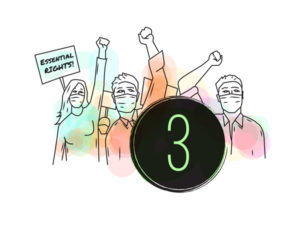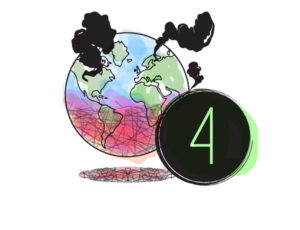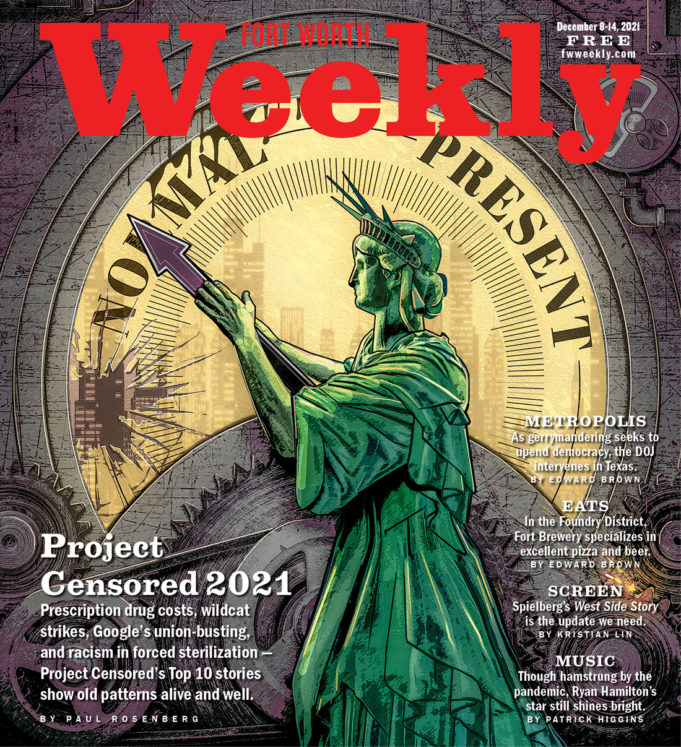Project Censored co-directors Mickey Huff and Andy Lee Roth title their introduction to this year’s edition of State of the Free Press “A Return to News Normalcy?,” drawing a direct parallel between our world today and that of post-WWI America, “when the United States faced another raging pandemic and economic recession,” with other sources of tumult as well: “The United States then had experienced a crackdown on civil liberties and free speech in the form of Espionage and Sedition Acts; racial tensions flared during the Red Summer of 1919 as violence erupted from Chicago to Tulsa; Prohibition was the law of the land; and the first wave of U.S. feminism ended with the passage of the 19th Amendment.” At the time, they noted, “People yearned for a return to ‘normalcy,’ as then–presidential hopeful Warren G. Harding proclaimed.”
But it was not to be. “The desire for simpler times, however, was more a phantom than a reality, as millions of Americans ultimately had to adjust to an ever- and fast-changing world,” including a rapidly changing media landscape — most notably the explosion of radio. And we should expect much the same. Every major change in the media landscape has brought with it the promise of expanded horizons and democratic possibility — the potential for a broader, more inclusive public conversation — only to see many of the old patterns of division, exclusion, and demonization recur in new ways as well as old, as recent revelations about Facebook vividly remind us.
Project Censored isn’t alone in drawing parallels to a century ago, of course. The pandemic above all has expanded journalistic horizons as a matter of necessity. To a lesser extent, the threat to American democracy — part of a worldwide trend of democratic backsliding — has done so as well, but while some have expanded their horizons, many more continue as if little or nothing has fundamentally changed. Day-to-day news stories perpetuate the fantasy that normal has already returned. And in one sense, they’re right. The normal patterns of exclusion and suppression that Project Censored has been tracking for over 40 years continue to dominate, with even the latest wrinkles fitting into well-established, if evolving, broad patterns that are depressingly familiar.
These patterns are reflected in Project Censored’s Top 10 list, with two stories each about labor struggles, racism, and threats to health, the environment, and free speech. Yes, that’s 12 stories, not 10, because some stories fit into more than one pattern — and some readers will surely find more patterns as well.
The point of Project Censored has never been just to expose significant stories that have been ignored but rather to expose them as portals to a wider landscape of understanding and action. In that spirit, here is our summary of this year’s Top 10 censored stories.

1.) Prescription Drug Costs Set to Become a Leading Cause of Death for Elderly Americans
“Soaring prescription drug costs have been widely reported by corporate news outlets,” Project Censored notes, but they’ve utterly ignored the staggering resulting cost in human lives.
More than 1.1 million seniors enrolled in Medicare programs could die prematurely in the next decade due to unaffordable prescription drugs, according to a November 2020 study reported on by Kenny Stancil for Common Dreams.
“As medicines become increasingly expensive, patients skip doses, ration prescriptions, or quit treatment altogether,” Project Censored explained, a phenomenon known as “cost-related nonadherence,” which will become “a leading cause of death in the U.S., ahead of diabetes, influenza, pneumonia, and kidney disease” by 2030, according to the study by the nonprofit West Health Policy Center and Xcenda, the research arm of Amerisource-Bergen, a drug distributor.
“Even with Medicare insurance, what seniors pay is linked to a drug’s price,” the study explained, which allowed the researchers “to model how cost-related nonadherence would change under policies that would reduce drug prices, such as Medicare negotiation.”
The study focused on five medical conditions that “significantly affect seniors and for which effective pharmaceutical treatments are available,” including three types of heart disease, chronic kidney disease, and type B diabetes.
“The good news is that policy changes can curb the power of Big Pharma, resulting in far fewer avoidable deaths,” Stancil reported.
As one of its key findings, the study stated, “Medicare negotiation is projected to reduce drug prices and seniors’ cost-sharing, which could prevent nearly 94,000 seniors’ deaths annually and save $475.9 billion.”
As a model for policymakers, the study pointed specifically to the Elijah E. Cummings Lower Drug Costs Now Act (HR 3), which passed the House in December 2019 but died in the Senate, Project Censored noted. It’s been reintroduced after Joe Biden “declined to include Medicare negotiation in his $1.8 trillion American Families Plan proposal,” they explained.
A May 2021 op-ed in The Hill, co-authored by Rep. Peter Welch (D-Vermont), cited the study’s figures on preventable deaths and explained its basic framework as such.
- HR 3 would limit the annual out-of-pocket costs for Medicare beneficiaries to no more than $2,000 and would establish a top negotiated price for drugs at no more than 120% of the average of six other wealthy nations.
- HR 3 would support and protect innovation and new drug development by investing some of the expected savings into the world-class research funded through the National Institutes of Health (NIH).
But this op-ed was a rare exception. “The public’s understanding of the debate surrounding HR 3 and other proposed legislation designed to control inflation in prescription drug prices ought to be informed by accurate information about the grim repercussions of continuing the status quo,” Project Censored noted. “Sadly, the corporate media have failed to provide the public with such information for far too long, and the consequences could turn out to be deadly for millions of seniors.”

2.) Journalists Investigating Financial Crimes Threatened by Global Elites
Financial crimes of global elites, involving the flow of dirty money through some of the world’s most powerful banks, have made major headlines in recent years, most notably with the Panama Papers in 2016 and the FinSen Files in 2020, but we’d know a great deal more if not for the flood of threats faced by journalists doing this work — a major story that hasn’t been told in America’s corporate media, despite a detailed report from Foreign Policy Centre (FPC), “Unsafe for Scrutiny,” released in November 2020.
The report was based on a survey of 63 investigative journalists from 41 countries, which found that 71% had experienced threats and/or harassment while doing their investigations, with a large portion of those (73%) experiencing legal threats as well. Its findings were described by Spencer Woodman in an article for the International Consortium of Investigative Journalists (ICIJ).
“The report found that legal threats are chief among the types of harassment facing journalists conducting financial investigations and often seek to exploit a skewed balance of power between often-underfunded reporting enterprises and the legal might of attorneys hired by the world’s wealthiest people and corporations,” Woodman wrote. “Focusing on frivolous cases known as ‘strategic lawsuits against public participation,’ or SLAPPs, the report asserts that such actions ‘can create a similar chilling effect on media freedom to more overt violence or attack.’ ”
Legal threats are often communicated via private letters, “and, if successful in achieving their aim, the public will never know,” the report said.
Physical threats and online harassment were also a grave concern, but they were geographically uneven. “While no journalists surveyed in North America reported physical threats, 60% of respondents working in sub-Saharan Africa and 50% of respondents from North Africa and the Middle East region reported threats of physical attack,” Woodman noted.
Daphne Caruana Galizia was murdered by a car bomb in Malta in October 2017, but, he added, “The report asserts that an assassination is often not a starting point for those seeking to silence reporters but instead a crime committed after a pattern of escalating threats, noting that Caruana Galizia had faced numerous legal threats and actions and that her family is still fighting 25 lawsuits over her reporting.”
Project Censored noted Galizia’s murder along with that of Slovak investigative journalist Ján Kuciak, adding that “According to FPC’s report, an additional 30 reporters from Brazil, Russia, India, Ukraine, Mexico, and other countries who were researching financial corruption have been murdered since 2017.”
As for legal threats, “Unlike Canada, Australia, and certain U.S. states, the United Kingdom has not passed anti-SLAPP legislation, making its courts an attractive venue for elites seeking to use the law to bully journalists into silence,” Project Censored noted, citing a May 8 Guardian column by Nick Cohen which described the U.K.’s court system as “the censorship capital of the democratic world.” Cohen in turn cited the case of financial reporter Catherine Belton, author of the 2020 book Putin’s People: How the KGB Took Back Russia and Then Took on the West. As Cohen explained, Project Censored observed, “in response, a host of Putin’s super-wealthy associates are now bombarding Belton with one lawsuit after another.”
The silence about this silencing has been deafening, Project Censored noted. There has been some coverage overseas, but “to date, however, no major commercial newspaper or broadcast outlet in the United States has so much as mentioned the FPC’s report.”

3.) Historic Wave of Wildcat Strikes for Workers’ Rights
After millions of people were designated “essential workers” when the country went into lockdown in March 2020, thousands of wildcat strikes erupted to challenge dangerous working conditions and chronic low wages, exacerbated by companies’ refusal to protect workers against COVID-19 and cutting or sharply increasing the cost of medical insurance for those who had it. A further strike surge was driven by “Black and Brown workers using digital technologies to organize collective actions as a way to press some of the demands for racial justice raised by Black Lives Matter and George Floyd protestors,” Project Censored noted.
The nation’s fourth busiest port, Charleston, South Carolina, shut down during Floyd’s funeral on June 9, for example.
At the labor news website Payday Report, Mike Elk created a continuously updated COVID-19 Strike Wave Interactive Map, which had identified “1,100 wildcat strikes as of March 24, 2021, many of which the corporate media have chosen to ignore,” according to Project Censored, including “more than 600 strikes or work stoppages by workers in solidarity with the Black Lives Matter movement,” in June 2020 alone, according to Elk’s data.
Project Censored said, “While local and regional newspapers and broadcast news outlets have reported on particular local actions, corporate news coverage has failed to report the strike wave as a wave, at no time connecting the dots of all the individual, seemingly isolated work stoppages and walkouts to create a picture of the overarching trend.”
The sole exception where there was national coverage was in August 2020 when highly paid baseball and basketball pro athletes walked out in violation of their contracts to protest the shooting of Jacob Blake by Wisconsin police. The coverage ended quickly once they returned a few days later.
Wildcat strikes occur when workers simply stop working, often in response to a specific incident, such as employer actions putting lives at risk by skimping on protective gear or attempting to cut workers’ health care. The situation was exacerbated by the Donald Trump administration’s failure to issue mandates requiring specific safety measures, as reported by Michael Sainato at The Guardian.
Examples covered by Elk that Project Censored cited include:
- In Santa Rosa, California, 700 health-care workers went on strike because their hospital lacked sufficient personal protective equipment to keep employees safe and management warned them that their insurance fees would be doubled if they wanted continued coverage for their families.
- In St. Joseph, Missouri, 120 sheet metal workers went on strike due to management’s repeated attempts to cut their health-care benefits during the pandemic.
- In May 2020, workers at 50 McDonald’s, Burger King, Starbucks, and other fast-food establishments throughout Florida staged a day-long strike for higher pay and better protective equipment.
- In April 2021, employees at Chicago-area Peet’s Coffee & Tea locations staged a coordinated work stoppage along with the Fight for $15 campaign to demand workplace protections and quarantine pay.
Furthermore, Elk noted that identifying roughly 600 strikes in solidarity with the Black Lives Matter movement “is likely a severe underestimation as many non-union Black and Brown workers are now calling out en masse to attend Black Lives Matter protests without it ever being reported in the press or on social media.”
Elk also noted that “many Black workers interviewed by Payday Report say that, once again, white labor leaders are failing to understand nontraditional organizing that has developed from viral social media movements. … Instagram automation and similar automation on Facebook and Twitter help to build a huge following for grassroots movements, so something that had no following a month ago can suddenly go viral and reach millions of people within hours or even minutes.”
That threat empowers even solitary individual workers, Tulsa-based Black filmmaker and activist Marq Lewis told Elk. He says he personally knows of multiple examples of Black workers in Tulsa approaching their bosses without the support of a union and winning changes in their workplace. Lewis said, “A lot of people may say, ‘This is not a strike.’ Well, you tell that to these workers now who are getting their grievances heard.”
That’s the censored story within the story within the story.

4.) “Climate Debtor” Nations Have “Colonized” the Atmosphere
The United States and other developed countries in the global north are responsible for 92% of all the excess carbon dioxide emissions driving global warming, according to a study in the September issue of The Lancet Planetary Health. The United States alone was responsible for 40%, followed by Russia and Germany (8% each), the United Kingdom (7%), and Japan (5%).
The study’s author, economic anthropologist Jason Hickel, told Sarah Lazare of In These Times that his research began from the premises that “the atmosphere is a common resource” and that “all people should have equal access” to a fair share of it. He calculated each nation’s fair share of a sustainable global carbon budget, based on population, along with an analysis of “territorial emissions from 1850 to 1969 and consumption-based emissions from 1970 to 2015.” In turn, this was used to calculate “the extent to which each country has overshot or undershot its fair share,” according to the study. Thus, the above list of the largest climate debtors.
The results, he told In These Times, show that “the countries of the Global North have ‘stolen’ a big chunk of the atmospheric fair shares of poorer countries and on top of that are responsible for the vast majority of excess emissions. … They have effectively colonized the global atmospheric commons for the sake of their own industrial growth.”
In contrast, the study found that “most countries in the Global South were within their boundary fair shares, including India and China (although China will overshoot soon).” The leading climate creditors to date are India (34% of global “undershoots”), China (11%), Bangladesh and Indonesia (5% each), and Nigeria (4%).
“High-income countries must not only reduce emissions to zero more quickly than other countries, but they must also pay down their climate debts,” the study said. “Just as many of these countries have relied on the appropriation of labor and resources from the Global South for their own economic growth, they have also relied on the appropriation of global atmospheric commons, with consequences that harm the Global South disproportionately.”
Other studies and analyses, Lazare noted, “have pointed to the disproportionate responsibility of the Global North, and wealthy countries, for driving the climate crisis.”
Most dramatically, she reported, a 2015 study by Oxfam International “found that the poorest half of the world’s population — roughly 3.5 billion people — are to blame for just 10% of ‘total global emissions attributed to individual consumption,’ yet they ‘live overwhelmingly in the countries most vulnerable to climate change.’ In contrast, the richest 10% of people in the world are responsible for roughly 50% of global emissions.”
Project Censored said, “Corporate news outlets appear to have entirely ignored the findings of Jason Hickel’s Lancet study.”
Although it may be imperative to act “quickly and together” to reduce carbon emissions, as Vice President Kamala Harris asserted at the April 2021 climate summit, corporate media have failed to cover Hickel’s cutting-edge research, which demonstrates that the United States and other would-be leaders in addressing climate change are, in fact — as the world’s worst climate debtors — disproportionately responsible for climate breakdown.”

5.) Microplastics and Toxic Chemicals Increasingly Prevalent in World’s Oceans
According to a pair of scientific studies published in the summer of 2020, microplastic particles and a family of toxic chemicals known as per- and polyfluoroalkyl substances or PFAS have become more widespread in the world’s oceans than previously realized and have begun to contaminate the global seafood supply. The two problems are related because PFAS — a family of highly stable “forever chemicals” with more than 4,700 known members — can occur as microplastics, they can stick to microplastic particles in water, and are involved in the production of plastics.
In July 2020, a German-American study published in the scholarly journal Environmental Science & Technology revealed that PFAS — which are used in a range of products, including carpets, furniture, clothing, food packaging, and nonstick coatings — have now been found in the Arctic Ocean.
“This discovery worries scientists,” Project Censored explained, “because it means that PFAS can reach any body of water anywhere in the world and that such chemicals are likely present in our water supply.”
This is concerning because, as Daniel Ross reported for Truthout, there are “known human health impacts … including certain cancers, liver damage, thyroid problems, and increased risk of asthma. As endocrine [disruptors], these chemicals have been linked to increased risk of severe COVID-19.”
Ross cited a number of other studies as well, noting that “emerging research suggests that one important pathway [for PFAS spreading] is through the air and in rainwater” and that they had been widely detected in China, the United States, and elsewhere.
“PFASs are probably detectable in ‘all major water supplies’ in the U.S.,” according to a study by the Environmental Working Group (EWG), Ross reported. “What’s more, over 200 million Americans could be drinking water containing PFAS above a level EWG scientists believe is safe, according to the organization’s most recent findings.”
The second study, in August 2020, also published in Environmental Science & Technology, came from researchers at the QUEX Institute, a partnership between the University of Exeter and the University of Queensland. They looked for and found microplastics (pieces of plastic, less than five millimeters in length — about the size of a sesame seed) in five seafood products sold in Australian markets: crabs, oysters, prawns, squid, and sardines, the last with the highest concentration.
According to the study’s lead author, as reported by Robby Berman in Medical News Today, a seafood eater with an average serving “could be exposed to … up to 30 mg of plastic when eating sardines,” about as much as a grain of rice.
Another co-author said, “We do not fully understand the risks to human health of ingesting plastic, but this new method [they used for detecting selected plastics] will make it easier for us to find out.”
Berman noted that “roughly 17% of the protein humans consume worldwide is seafood. The findings, therefore, suggest people who regularly eat seafood are also regularly eating plastic.”
Aside from The Guardian, “no major news outlet has paid attention to the topic of microplastics in seafood,” Project Censored noted, referring to an October 2020 story by Graham Readfearn, reporting on a new Australian study indicating that at least 14 million tons of microplastics are likely sitting on the ocean floor — “more than 30 times as much plastic at the bottom of the world’s ocean than there is floating at the surface.”
However, the study’s co-author, Dr. Denise Hardesty, “said the amount of plastic on the ocean floor was relatively small compared to all the plastics being released, suggesting the deep-sea sediments were not currently a major resting place for plastics,” Readfearn reported. “Leaders from more than 70 countries signed a voluntary pledge in September to reverse biodiversity loss which included a goal to stop plastic entering the ocean by 2050,” but major countries, including the United States, Brazil, China, Russia, India, and Australia, had not signed on.

6.) Canary Mission Blacklists Pro-Palestinian Activists, Chilling Free Speech Rights
Before the moral panic over Critical Race Theory fueled a nationwide uprising to censor discussions of race in education, there was an opposite moral panic decrying “cancel culture” stifling certain people — especially in education — but even at the peak of the “cancel culture” panic, perhaps the most canceled people anywhere in America — pro-Palestinian activists and sympathizers — received virtually no attention. Even though a well-funded, secretly run blacklist website known as Canary Mission explicitly targeted thousands of individuals — overwhelmingly students — with dossiers expressly intended to ruin their careers before they even began and which “have been used in interrogations by Israeli security officials,” according to The Forward, a Jewish publication, they’ve also been used by the FBI, as reported by The Intercept.
The website, established in 2015, “seeks to publicly discredit critics of Israel as ‘terrorists’ and ‘anti-Semites,’ ” Project Censored noted, but its careless style of accusation has caused a backlash, even among pro-Israeli Jews. The Forward reported, “While some of those listed on the site are prominent activists, others are students who attended a single event or even student government representatives suspected of voting for resolutions that are critical of Israel.”
More than that, The Forward reported three examples when Canary Mission was apparently retaliating against critics, including Jews, but, by far, its main targets are Palestinians, particularly activists involved with the global BDS movement (Boycott, Divestment, and Sanctions) that works to peacefully pressure Israel — similarly to South Africa in the 1980s — to obey international law and respect Palestinians’ human rights. As The Intercept reported in 2018, “While Canary Mission promotes itself as a group working against anti-Semitism, the blacklist’s effective goal is to clamp down on growing support for Palestine in the United States by intimidating and tarnishing Palestinian rights advocates with the brush of bigotry.”
While the FBI told The Intercept that it “only investigates activity which may constitute a federal crime or pose a threat to national security,” this didn’t match up with its actions.
“If the FBI was concerned about criminal activity among the student activists, its agents made no indication of that in the interviews,” The Intercept reported. “They did, however, ask questions that echoed far-right propaganda about unproven links between pro-Palestine activist groups and militant groups.”
The list itself has had a chilling effect on First Amendment rights, another Intercept story reported. “A survey of over 60 people profiled on Canary Mission, conducted by the group Against Canary Mission, found that 43% of respondents said they toned down their activism because of the blacklist, while 42% said they suffered acute anxiety from being placed on the website.”
Some have even received death threats.
“For many otherwise unknown activists, a Canary Mission profile is their most visible online presence,” Project Censored reported. “ ‘It’s the first thing that comes up when you google my name, the claim that I’m a terrorist supporter and an extremist,’ one former activist on Palestinian issues told The Intercept.
“Beyond Canary Mission,” Projected Censored continued, “a variety of pro-Israel organizations that seek to suppress pro-Palestinian activism have pursued litigation against chapters of Students for Justice in Palestine,” as reported in The Nation by Lexi McMenamin. A highlighted example at UCLA demanded the release of the names of speakers at a national conference, whose identities had been protected “in order to prevent them from being put on no-fly lists, potentially denied entry to other countries, or contacted by the FBI over their organizing work.”
In March 2021, a California judge rejected that demand, noting that disclosure of their names “would violate their rights to freedom of association, anonymous speech, and privacy.”
Project Censored also cited a May 2021 federal court ruling that the state of Georgia cannot compel groups or individuals who contract with public entities to disavow support for the BDS movement against Israel, finding that the state’s law “places an unconstitutional incidental burden on speech.”
Georgia is one of 35 states with similar anti-BDS laws or executive orders.
“Heightened violence in Israel/Palestine in May 2021 has focused attention on powerful pro-Israel media biases in U.S. news coverage, but Canary Mission and legal efforts to suppress pro-Palestinian activism have nonetheless received minimal corporate news coverage,” Project Censored summarized, citing a handful of exceptions, op-eds in The New York Times and Washington Post, plus two New York Times articles “dating back to 2018 [that] made passing mention of Canary Mission as a ‘shadowy organization,’ ” but, as Project Censored concluded, “aside from this coverage, major establishment news outlets have provided no substantive reports on the role played by Canary Mission and other pro-Israel organizations in stifling the First Amendment rights of pro-Palestinian activists.”

7.) Google’s Union-Busting Methods Revealed
In 2018, Google dropped its long-time slogan, “Don’t be evil” from its code of conduct. In 2019, Google hired IRI Consultants, a union avoidance firm, “amid a wave of unprecedented worker organizing at the company,” as Vice’s Motherboard put it in January 2021, while reporting on leaked files from IRI provided a disturbing picture of how far Google may have strayed in its willingness to sabotage its workers’ rights.
The 1935 National Labor Relations Act makes it illegal for companies to spy on employees and guarantees workers the right to organize and engage in collective bargaining. “Nevertheless,” Project Censored noted, “companies like Google attempt to circumvent the law by hiring union avoidance firms like IRI Consultants as independent contractors to engage in surveillance and intimidation on their behalf.”
As Lauren Kaori Gurley reported for Motherboard, “Employers in the United States spend roughly $340 million on union avoidance consultants each year,” but their practices are apparently so disreputable that IRI doesn’t identify its clients on its website “beyond saying the firm has been hired by universities, renewable energy companies, automakers, ‘the nation’s largest food manufacturers,’ and ‘several Top 10 worldwide retailers,’ ” she reported.
John Logan, a professor of labor and employment studies at San Francisco State, told Gurley, “Consultants specialize in operating in the gray areas of the law. They’re not quite illegal, but they’re sort of bending the law if they’re not breaking it.”
Project Censored noted, “The [leaked] documents show that the firm collected incredibly detailed information on 83 Seattle hospital employees, including their ‘personality, temperament, motivations, ethnicity, family background, spouses’ employment, finances, health issues, work ethic, job performance, disciplinary history, and involvement in union activity’ in the lead-up to a union election, including descriptions of workers as ‘lazy,’ ‘impressionable,’ ‘money oriented,’ and ‘a single mother.’ ”
The documents Motherboard reported on didn’t come from Google but from two Seattle-based hospitals owned by Conifer Health Solutions, who hired IRI on the sly — a common practice.
“Tracking the union avoidance firms behind anti-union campaigns is intentionally made difficult by firms that subcontract out work to other firms that hire independent contractors to avoid federal reporting requirements laid out by the Department of Labor and shield themselves from public scrutiny,” Motherboard explained, adding that the union organizing the workers had no idea of IRI’s involvement.
Project Censored noted, “Google is not the only Big Tech company to enlist union-avoidance consultants in recent years. In fall 2020 and spring 2021, employees at Amazon’s massive fulfillment center in Bessemer, Alabama, launched a much-publicized unionization effort. As John Logan detailed in a lengthy article for LaborOnline, Amazon responded to the Bessemer drive by spending at least $3,200 per day on anti-union consultants Russ Brown and Rebecca Smith and by bringing in a second union-busting consulting firm,” as well as hiring “one of the largest law firms in the country specializing in union avoidance.”
Employees voted more than 2-1 against joining the union, but the election was overturned for a set of eight labor law violations after Project Censored’s book went to the publisher — a decision that Amazon is appealing.
“There has been some establishment press coverage of large corporations hiring union-avoidance firms to undermine workplace organizing, mostly focusing on tech giants like Google and Amazon,” Project Censored noted, including late 2019 stories in The New York Times and Washington Post reporting that Google had hired IRI, and a Feb. 23, 2020, New York Times Magazine cover story entitled “the Great Google Revolt,” which “mentioned in passing” the use of anti-union consultants by Google and others in Silicon Valley.
“However, there has been no corporate news coverage whatsoever of the sensational leaks that Motherboard released in January, and there has been very little in-depth corporate media reporting on the use of union-busting consultants in general,” Project Censored summed up, concluding, “The documents leaked to Motherboard confirm and greatly elaborate upon what labor organizers and educators have suspected of the specific tactics the union-busting firms employ.”

8.) Pfizer Bullies South American Governments over COVID-19 Vaccine
“Pfizer has essentially held Latin American governments to ransom for access to its lifesaving COVID-19 vaccine,” Project Censored reported, the latest example of how it has exerted undue influence to enrich itself at the expense of low- and middle-income nations going back to the 1980s, when it helped shape the intellectual property rules it’s now taking advantage of.
“Pfizer has been accused of ‘bullying’ Latin American governments in COVID vaccine negotiations and has asked some countries to put up sovereign assets, such as embassy buildings and military bases, as a guarantee against the cost of any future legal cases,” according to reporters at the Bureau of Investigative Journalism (BIJ).
In one case, it resulted in a three-month delay in reaching a deal.
“For Argentina and Brazil, no national deals were agreed at all,” BIJ reported. “Any hold-up in countries receiving vaccines means more people contracting COVID-19 and potentially dying.”
It’s normal for governments to provide some indemnity, but “Pfizer asked for additional indemnity from civil cases, meaning that the company would not be held liable for rare adverse effects or for its own acts of negligence, fraud, or malice,” BIJ reported. “This includes those linked to company practices — say, if Pfizer sent the wrong vaccine or made errors during manufacturing.”
The director of the Collaborating Center on National and Global Health Law at the World Health Organization (WHO), Lawrence Gostin, told BIJ, “Some liability protection is warranted but certainly not for fraud, gross negligence, mismanagement, [or] failure to follow good manufacturing practices. Companies have no right to ask for indemnity for these things.”
During negotiations, which began in June 2020, “the Argentinian government believed that, at the least, Pfizer ought to be accountable for acts of negligence on its part in the delivery and distribution of the vaccine, but instead of offering any compromise, Pfizer ‘demanded more and more,’ according to one government negotiator,” Project Censored summarized. “That was when Pfizer called for Argentina to put up sovereign assets as collateral. Argentina broke off negotiations with Pfizer, leaving the nation’s leaders at that time without a vaccine supply for its people,” in December.
An Argentine official told BIJ, “It was an extreme demand that I had only heard when the foreign debt had to be negotiated, but both in that case and in this one, we rejected it immediately.”
That same month, just after the United States approved Pfizer’s COVID-19 vaccine for emergency use, In These Times’ Sarah Lazare filed a detailed report on the history of the pharmaceutical giant’s opposition to expanding vaccine access to poor countries, beginning in the mid-1980s during the negotiations that eventually resulted in the establishment of the World Trade Organization in 1995.
“Both globally and domestically,” she explained, “Pfizer played an important role in promoting the idea that international trade should be contingent on strong intellectual property rules while casting countries that do not follow U.S. intellectual property rules as engaging in ‘piracy,’ ” a view they promoted to multiple business networks, shielded from wider public debate. “It was not a given, at the time, that intellectual property would be included in trade negotiations. Many Third World countries resisted such inclusion, on the grounds that stronger intellectual property rules would protect the monopoly power of corporations and undermine domestic price controls.
“It is difficult to think of a clearer case for suspending intellectual property laws than a global pandemic,” she continued, and “a swath of global activists, mainstream human rights groups, and UN human rights experts have added their voices to the demand for a suspension of patent laws,” but Pfizer was joined in its opposition by pharmaceutical trade groups and individual companies, such as Moderna, another COVID-19 vaccine maker.
As a result, “One could make a map of global poverty, lay it over a map of vaccine access, and it would be a virtual one-to-one match,” she wrote. “Once again, majority Black and brown countries, by and large, are left to suffer and die.”
Project Censored noted, “Pfizer’s dealings in South America are not exactly secret, but as of May 2021, there has been no corporate media coverage of Pfizer’s actual dealings in South America or how the pharmaceutical giant helped establish the global intellectual property standards it now invokes to protect its control over access to the vaccine.”
Nor is this anything new, it concluded: “Big Pharma has a long, underreported track record of leaving developing nations’ medical needs unfulfilled, as Project Censored has previously documented.”

9.) Police Use Dogs as Instruments of Violence, Targeting People of Color
The use of vicious dogs to control Black people dates back to slavery, but it’s not ancient history, according to an investigative series of 13 linked reports titled Mauled: When Police Dogs Are Weapons, coordinated by the Marshall Project in partnership with AL.com, IndyStar, and the Invisible Institute. They found evidence that the pattern continues to this day, with disproportionate use of police dogs against people of color, often resulting in serious injury, with little or no justification. Baton Rouge, Louisiana, a majority-Black city of 220,000, is the dog-bite capital of America, with a bite rate more than double the next-ranked city, Indianapolis. According to Bryn Stole and Grace Toohey’s February 2021 report, between 2017 and 2019, Baton Rouge police dogs bit at least 146 people, records show. Of those, 53 were 17 years old or younger. The youngest were just 13. Almost all of the people bitten were Black, and most were unarmed and suspected by police of nonviolent crimes like driving a stolen vehicle or burglary.
But Baton Rouge is hardly alone. Approximately 3,600 Americans annually are sent to the emergency room for severe bite injuries resulting from police dog attacks. These bites “can be more like shark attacks than nips from a family pet, according to experts and medical researchers,” a team of five reporters wrote in October 2020, as part of a summary of the main finding of their research. Other highlights from the series include:
- “Though our data shows dog bites in nearly every state, some cities use biting dogs far more often than others.”This ranged from just one incident in Chicago from 2017 to 2019 to more than 200 in Los Angeles and more than 220 in Indianapolis.
- “Most bite victims are men, and studies suggest that in some places, they have been disproportionately Black.” This includes the Ferguson, Missouri, police department and the Los Angeles County Sheriff’s Department, where it’s been found that “dogs bit non-White people almost exclusively.”
- “Bites can cause life-altering injuries, even death. Dogs used in arrests are bred and trained to have a bite strong enough to punch through sheet metal.”
- “Many people bitten were unarmed, accused of nonviolent crimes or weren’t suspects at all.”
- “Some dogs won’t stop biting and must be pulled off by a handler, worsening injuries.”
- “There’s little accountability or compensation for many bite victims,” for a wide range of reasons. “Even when victims can bring cases, lawyers say they struggle because jurors tend to love police dogs,” what’s known as the Lassie Effect.
Though the Black Lives Matter movement has significantly raised public awareness of police using disproportionate force against people of color, police “K-9 violence has received strikingly little attention from corporate news media.”
There were exceptions. In October 2020, USA Today and the Marshall Project published a Marshall Project story simultaneously, and in November 2020, the Washington Post ran a front-page story citing the Marshall Project’s reporting. In addition, NBC News covered Salt Lake City’s suspension of its K-9 program “after a video circulated of a police dog biting a Black man who was kneeling on the ground with his hands held up.” But aside from these examples, “coverage appears to have been limited to local news outlets,” Project Censored concluded.

10.) Activists Call Out Legacy of Racism and Sexism in Forced Sterilization
Forced sterilization was deemed constitutional in the 1927 Supreme Court decision Buck v. Bell, after which forced sterilizations increased dramatically, to at least 60,000 in some 32 states during the 20th Century, predominantly targeting women of color. And while state laws have been changed, forced sterilization is still constitutional and still going on today — with at least five cases of women in custody by Immigration and Customs Enforcement (ICE) in Georgia in 2019 — while thousands of victims await restitution, as reports from The Conversation and YES! Magazine have documented.
“Organizations such as Project South, California Latinas for Reproductive Justice, and the Sterilization and Social Justice Lab are actively working to document the extent of this underreported problem — and to bring an end to it,” Project Censored noted, but their work is even more underreported than the problem itself.
“During the height of this wave of eugenics by means of sterilization in the U.S., forced hysterectomies were so common in the Deep South that activist Fannie Lou Hamer coined the term ‘Mississippi Appendectomy’ to describe them,” Ray Levy Uyeda wrote in the YES! Magazine article “How Organizers Are Fighting an American Legacy of Forced Sterilization,” which begins with the story of Kelli Dillon. A California prison inmate, she underwent a procedure in 2001 to remove a potentially cancerous growth — and the surgeon simultaneously performed an unauthorized hysterectomy, one of 148 forced sterilizations that year in California prisons and one of 1,400 carried out between 1997 and 2010.
Dillon began organizing inside the women’s prison gathering testimonials from other victimized prisoners “and provided the personal accounts to staff at Justice Now that was laying the groundwork to petition for legislation that would ban the procedures in prisons,” Uyeda reported.
She eventually sued the state of California for damages and helped to shape legislation to compensate victims (finally passed this year), a story told in the 2020 documentary film Belly of the Beast.
In The Conversation, Alexandra Minna Stern wrote, “All forced sterilization campaigns, regardless of their time or place, have one thing in common: They involve dehumanizing a particular subset of the population deemed less worthy of reproduction and family formation.”
Stern directs the Sterilization and Social Justice Lab, where “our interdisciplinary team explores the history of eugenics and sterilization in the U.S. using data and stories” — 35,000 of them so far captured from “historical records from North Carolina, California, Iowa, and Michigan.”
The history is more complicated than one might expect, Stern explains. “At first, sterilization programs targeted white men, expanding by the 1920s to affect the same number of women as men. The laws used broad and ever-changing disability labels like ‘feeblemindedness’ and ‘mental defective.’ Over time, though, women and people of color increasingly became the target, as eugenics amplified sexism and racism. It is no coincidence that sterilization rates for Black women rose as desegregation got underway.”
Uyeda wrote, “California Latinas for Reproductive Justice is working to secure legislative change for victims of the state’s sterilization efforts between 1909 and 1979.”
It was signed into law after Project Censored’s book went to print, making California the third state with such legislation, following the lead of North Carolina and Virginia, in 2013 and 2015, respectively.
“The history of eugenics has been thoroughly researched and criticized by scholars and human rights activists, but coverage by the corporate media of the U.S. practice of forced sterilization throughout the 20th century and into the 21st has tended to be limited and narrowly focused,” Project Censored noted.
There was some corporate news coverage after the ICE forced sterilization stories emerged but generally without “any mention of the activists resisting the practice. … Some establishment press articles on the topic of forced sterilization include comments from members of these organizations to provide context on the issue, but few spotlight the groups’ tireless organizing and record of accomplishments.”
Two exceptions cited were articles from Marie Claire and Refinery29, a website for young women. This only began to change in July 2021, as Project Censored’s book was going to print, “with the Associated Press and other establishment news outlets reporting that California is preparing to approve reparations of up to $25,000 per person to women who had been sterilized without consent.”












